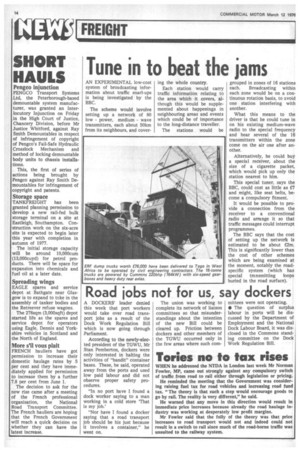Tune in to beat the jams
Page 16

If you've noticed an error in this article please click here to report it so we can fix it.
AN EXPERIMENTAL low-cost system of broadcasting information about traffic snarl-ups is being investigated by the BBC.
The scheme would involve setting up a network of 80 low power, medium wave transmitters, each about 50km from its neighbours, and cover ing the whole country.
Each station would carry traffic information relating to the area which it covers, although this would be supplemented about happenings in neighbouring areas and events which could be of importance to the long-distance traveller.
The stations would be grouped in zones of 16 stations each. Broadcasting within each zone would be on a continuous rotation basis, to avoid one station interfering with another.
What this means to the driver is that he could tune in on his existing medium-wave radio to the special frequency and hear several of the 16 transmitters within the zone come on the air one after another.
Alternatively, he could buy a special receiver, about the size of a cigarette packet, which would pick up only the station nearest to him.
This special tuner, says the BBC, could cost as little as £7 and might, like seat belts, become a compulsory fitment.
It would be possible to provide a connection from the receiver to a conventional radio and arrange it so that traffic messages could interrupt programmes.
The BBC says that the cost of setting up the network is estimated to be about £2m. This is significantly lower than the cost of other schemes which are being examined at the moment, notably the roadspecific system (which has special transmitting loops buried in the road surface).
















































































































